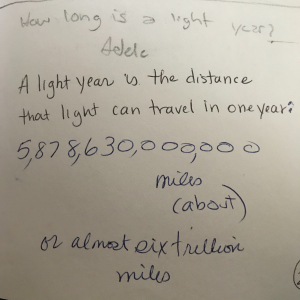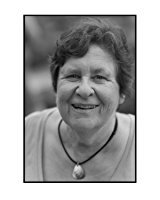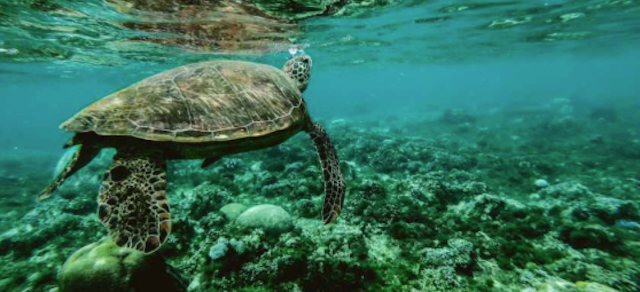Does photosynthesis work the same in underwater plants as land plants?
This perceptive query about photosynthesis asked in a fifth grade botany class led to one of those moments when curiosity electrified our classroom. When I admitted I didn’t know the answer yet, my students gave me an assignment.
“Will you find out and tell us?”
By fourth or fifth grade, and sometimes sooner, kids ask questions that a teacher can’t always answer accurately on the spot. These are the types of inquiries that call for an answer, not those questions that are better used as a lead in to a conversation. My teaching memoir, A Gift of Wonder, A True Story Showing School as it Should Be, brings readers into my classroom to witness many such conversations.
 While I wanted to remain open to altering my lesson plan to allow a good question to evolve into a student led discussion, I also wanted to encourage challenging factual questions to keep coming. So, I started The Question Book. Whenever a question stumped the class and me, I asked the questioner to write the query in a blank notebook. After class, I did the necessary research and wrote the answer in the notebook.
While I wanted to remain open to altering my lesson plan to allow a good question to evolve into a student led discussion, I also wanted to encourage challenging factual questions to keep coming. So, I started The Question Book. Whenever a question stumped the class and me, I asked the questioner to write the query in a blank notebook. After class, I did the necessary research and wrote the answer in the notebook.
I also encouraged children to enter questions that were tangentially related to our class topics and, when possible, to provide answers to their classmates inquiries in the book. Once, when I left the book on my desk during a parent evening, a dad kindly responded to one of the questions.
Soon I found that we had accidentally stumbled upon a method for helping children in ways that transcended seeking facts. Sometimes students wrote questions that they might be too embarrassed to ask publicly.
How is a flatulence formed? from the sixth grade Question Book (my answer at the end of this post)
My students also used The Question Book could as a place to explore deep questions.
Is there a God? (Student answer at the end of this post)
The Question Book also allowed children to ask what might be considered dumb questions. This one might cause you to giggle, but it turned out to be more perceptive than I guessed:
Are Venice and Venezuela the same thing? from the sixth grade Question Book (my answer at the end of this post)
In our era of quick information from the web, one might ask: why not simply tell the questioner to “google it”? Indeed, my students often came to school with facts related to our lessons that they gleaned from the internet because they were curious enough to google the topics of the week. However, many fourth, fifth and sixth grade students don’t have the patience or discernment to find understanding from a few websites that give partial answers. A well researched, concise answer from the teacher shows them that their curiosity is valued and builds a bond between teacher and student.
I think most teachers possess an instinct that leads them to nurture curiosity. And, like most teachers, I tried to create lessons that would spark inquiry. Nevertheless, far beyond my expectation, the addition of The Question Book seemed to turn curiosity up a notch in my classes, to enliven what researchers call a “curious state.”
It turns out that three researchers at the University of California at Davis have discovered that entering a “curious state” is akin to removing an unseen veil that stands between us and ease in learning. In 2014, neuroscientists Matthias Gruber, Bernard Gelman and Charan Ranganath, explored the effects of states of curiosity on learning. They discovered what teachers have long suspected: that we learn more efficiently when curious. They even showed, through the use of MRI’s of the brains of people in a curious state, the internal structures and pathways that support curiosity.
Which is larger Monaco or Andorra? from the sixth grade Question Book (my answer at the end of the article)
We are used to the idea that teachers should ask and answer most classroom questions and then ask the same, predictable questions on a test. What would happen were we to turn this around? What if teachers created engaging lessons with the explicit purpose of stimulating questions that would shape the next day’s lesson? What if teachers were allowed to focus on developing curiosity rather than high test scores?
* * *

from the sixth grade question book
If you are a teacher curious about using a Question Book in your classroom or a parent who might try this at home, please give this method a trial and get back to me with your observations! I would like to write a follow up post that includes your experiences with Question Books. Write to me here
Answers:
Photosynthesis in aquatic plants is very similar to photosynthesis in land based plants. In both water plants and land plants, sunlight powers the plant to transform water and carbon dioxide so that oxygen is released and and glucose is created. The plants use this glucose for energy and for growth. While land plants receive water for this process from their roots, aquatic plants get water from their surroundings. Land plants get carbon dioxide from the air, while aquatic plants get dissolved carbon dioxide from the water. Fun fact: When you drink soda, the bubbles are dissolved carbon dioxide.
Flatulence: Food is digested as it passes through the digestive system. This means that it is broken down into tiny bits that move into the bloodstream to be used for energy, growth and repair. Most food is digested in the stomach and the small intestine. (The small intestine is called “small” because it has a narrow diameter.) Any undigested food that enters the large intestine is broken down by bacteria that normally live in this organ. This bacterial digestion process creates gasses including methane, hydrogen and hydrogen sulfide. (from the sixth grade Question Book)
Is there a God? student answer: There is no proof, but it is up to you if you want to believe in him/her or not. I believe in him. I can tell him what I think and then I feel better. (from the sixth grade question book)
Venice and Venezuela: The South American country Venezuela owes its name to the city of Venice. When Amerigo Vespucci explored the coast of northeast South America in 1499, he observed villages that were composed of small houses on stilts. This reminded him of Venice and he named this area Veneziela. Eventually this name evolved to Venezuela and was used for the whole country. This was a perceptive question! (from the sixth grade Question Book)
Monaco and Andora: Andorra is larger. Monaco has .75 square miles. Andorra has 181 square miles.
References:
This is a post I wrote for parents and teachers about those questions that are good lead-ins to a conversation: Seven Reasons to Not (always) Answer Your Child’s Questions.
A piece by By Maanvi Singh in WQED about the research mentioned in this post:
What’s Going On Inside the Brain of A Curious Child
States of Curiosity Modulate Hippocampus-Dependent Learning via the Dopaminergic Circuit
The research paper about states of curiosity cited in this post.
Written by Kim Allsup for and published by Growing Children ~ March 6, 2018.
 ~ The Author ~
~ The Author ~
Kim Allsup’s childhood wonder years inspired her first career as an environmentalist and her second career as a Waldorf teacher. She was the founding staff member of the Buzzard Bay Coalition and a founding parent of the Waldorf School of Cape Cod. A graduate of Brown University and Antioch University (M.Ed), she served as a Waldorf class teacher, on Cape Cod and at the Pine Hill Waldorf School, for 22 years. She is currently a writer, an advisor to teachers and a gardening teacher pioneering the use of school sunhouses. She lives on Cape Cod with her husband and blogs at Growing Children.
She is the author of A Gift of Wonder, A True Story Showing School as it Should Be. Kim Allsup was an elementary and middle school teacher for 25 years. Her teaching memoir, A Gift of Wonder, A True Story Showing School as it Should Be shows the importance of curiosity, wonder, engagement and spontaneity in learning and teaching. Click to follow her on Facebook and on her blog Growing Children


Photo synthesis. A chlorophyl molecule is a very intricate complicated molecule that scientist call a ‘pyro-molecule’ because it uses energy to transform and liberate another complicated molecule, in a plant’s case, it uses photon packets to make sugar molecules. The center piece of chlorophyl is a lil’ wee particle of the metal called magnesium.
Our blood has another sort o’ intricate, complicated pyro-molecule. It takes oxygen outta the air, in a similar fashion to how a chlorophyl molecule transmutes sugar outta the sun shine. Our hemoglobin pyro-molecules don’t have magnesium at their core, though; ours have another metal…, Iron.
There’s Iron in yer words, Josie Wales….